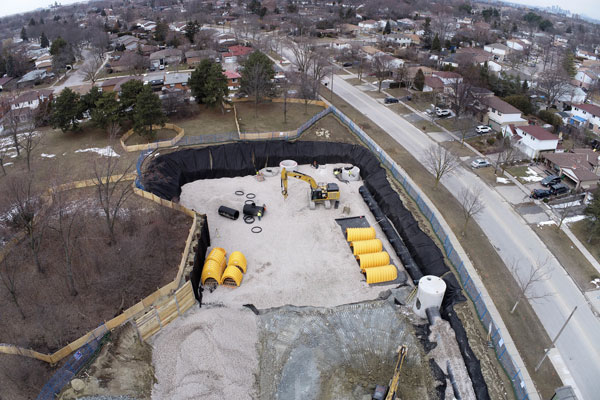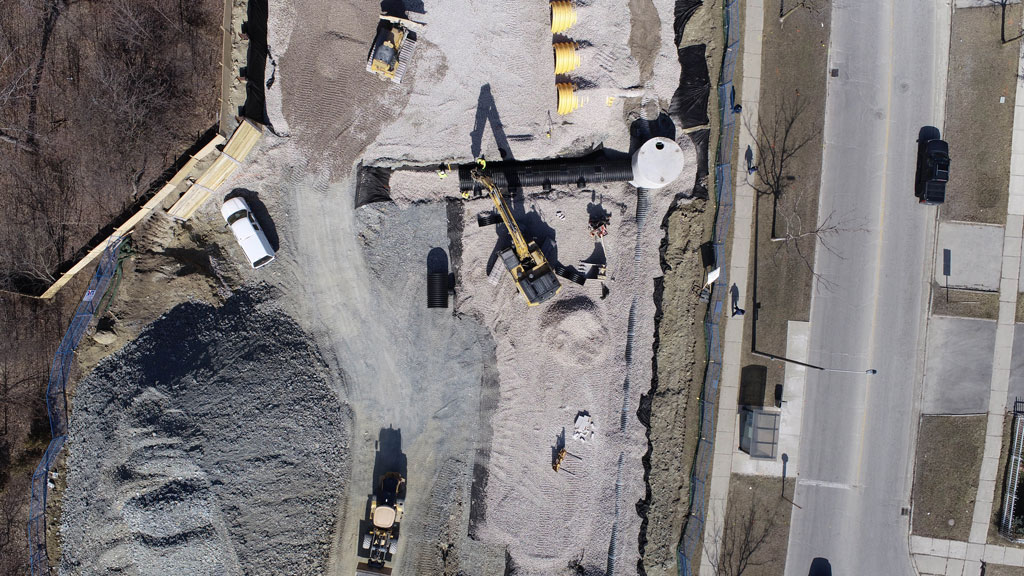In an almost back-to-back scenario, two major storms slammed into the Greater Toronto Area in July and August causing considerable damage.
The impact was particularly severe in Mississauga where approximately 170 millimetres of rain fell in some areas causing considerable flooding of residential basements and some highways.
As serious and potentially dangerous as the storms were, city officials say the situation could have been considerably worse if the municipality hadn’t invested time and money in transforming several parks into massive stormwater retention areas.
Large underground modular holding tanks have been installed in four parks in the Cooksville Creek watershed since 2017.
Those parks are Eastgate Park, Sandalwood Park, Mississauga Valley and McKenzie Park where contractor D’Orazio Infrastructure Group completed the installation just a few weeks ago.
The tanks at Eastgate, Sandalwood and McKenzie are arch chamber systems constructed of HDP (high density polyethrene).
Ground conditions at the Mississauga Valley Park necessitated the installation of an underground cast-in-place concrete tank with a sacrificial form system, says Mark Bassingthwaite, president of Resilient Consulting, the city’s consultant.

Varying in size from 14,100 square metres at Sandalwood Park to 5,250 square metres at Mississauga Valley, the tanks are designed to hold back stormwater and then slowly release the flows, stemming from large severe storms such as those that occurred in July and August, he says.
Mississauga is “definitely a leader” in the use of the chambers on a watershed basis. They have been installed in other municipalities, but primarily on a “one-off” basis, says Bassingthwaite.
As the parks are located in proximity to large storm sewers, they provide a cost-effective method of diverting the flows, says Mississauga’s director of infrastructure planning and engineering services, Emma Calvert.
A consultant’s study was the catalyst for the decision to harness the benefits of parks as a stormwater control measure. Completed in 2012, the Cooksville Creek Flood Evaluation highlighted the advantages of holding back stormwater flows in the upper part of the Cooksville Creek watershed, she says.

The study was a “master plan” that followed an environmental assessment consultation process which “set the table” for the detailed design work at the park sites.
Asked about the technical/construction details about the installation, she explains that it first begins with the closing of the parks and removing playground and other equipment.
“After that, the excavation stage begins and that involves the proper handling of excess soils so that they are transported and properly disposed in compliance with soil management regulations.”
Next the tanks and the supporting infrastructure are installed.
Then the entire system is backfilled and the park restored and gradually reopened, she says.
The entire process can take approximately four to eight months and during that time the local residential community can’t use the park.
But the city does give advance notice of the closure and works with sports leagues to relocate to other parks on a temporary basis. For the most part there little negative comments about the closures, she says.
“The public gets a refreshed park following the completion of the project.”
As the city anticipates that storms of the magnitude that occurred in July and August of this year, it’s committed to having the infrastructure in place to mitigate flooding
Design is currently underway for fifth project at Huron Heights and the city also has long term plans to install the underground tanks at Greyshale and Heritage Hills parks, says Calvert.




Recent Comments